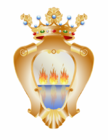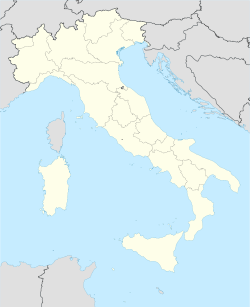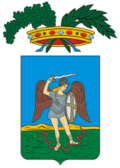Foggia
| Comune di Foggia | |
|---|---|
 Municipal coat of arms |
|
 |
|
| Country | |
| Region | Puglia |
| Province | Foggia (FG) |
| Mayor | Orazio Ciliberti |
| Elevation | 76 m (249 ft) |
| Area | 507 km² (195.8 sq mi) |
| Population (as of December 31, 2004) | |
| - Total | 154,780 |
| - Density | 305/km² (790/sq mi) |
| Time zone | CET, UTC+1 |
| Coordinates | |
| Gentilic | Foggiani |
| Dialing code | 0881 |
| Postal code | 71100 |
| Frazioni | Borgo Mezzanone, Arpinova, L'Incoronata, Cervaro, Tavernola, Segezia |
| Patron | Madonna dei Sette Veli |
| - Day | March 22 |
| Website: www.comune.foggia.it | |
Foggia is a city of Puglia, Italy, capital of the province of Foggia. Foggia is the main city of a plain called Tavoliere, also known as the "granary of Italy".
Contents[hide] |
History
The name Foggia derives from Latin "fovea", meaning "pit", referring to the pits where wheat was stored. Although the area had been settled since Neolithic times, and a Greek colony known as Argos Hippium existed nearby, the first document attesting the existence of the modern city dates from 1000 AD: according to the legend, the first settlers were peasants who had found a panel portraying the Madonna, on which three flames burnt.
The area was marshy and unhealthy, being partially dried under Robert Guiscard, who therefore boosted the economic and social growth of the city. The city was the seat of Henry, Count of Monte Sant'Angelo during the last twenty years of the 11th century. In the 12th century, William II of Sicily built a cathedral here and further enlarged the settlement.
Frederick II had a palace built in Foggia in 1223, in which he often sojourned. It was also seat of his court and a studium, including figures such as Michael Scot, but little of it remains now.
In 1447 King Alfonso V of Aragon built a Custom Palace to tax the local sheep farmers, but this caused a decline of the local economy and the progressive ruin of the land, which again became marshy.
In 1456 an earthquake struck Foggia, followed by others in 1534, 1627 and 1731, the latter destroying one third of the city. The House of Bourbon, however, promoted a certain economical growth by boosting the cereal agriculture of Capitanata and rebuilding much of the settlement.
In the 19th century, Foggia received a railway station and important public monuments. The citizens also took part in the riots, which led to the annexation to Italy in 1861.
By 1865, there was a definitive shift from the custom of sheep farming in favour of an agricultural economy. The historical lack of water resources was solved with the construction of the Apulian aqueduct in 1924, when Foggia was already an important hub between northern and southern Italy.
This role pushed the Allies to bomb the city during World War II, in particular on July 22 and August 19 1943, reducing it to rubble. On October 1 1943 the Allies conquered Foggia, making it a stronghold of their slow offensive towards the north of the peninsula. In 1959 and 2006 Foggia received, respectively, the Gold Medal for Civil and Military value for its role in World War II.
The makers of the well-known American TV sitcom "All in the Family" included in the biography of the main character Archie Bunker a World War II service at Foggia, in the ranks of the United States Army Air Corps.
Main sights
- The cathedral of Santa Maria de Fovea, which is directly linked with the patron saint "Madonna dei Sette Veli" (Madonna of the Seven Veils)
- Palazzo Dogana, the historical seat of the sheep custom.
- Chiesa delle Croci ("Church of the Crosses").
- The Three Arches.
- Arco di Federico II ("Arch of Frederick II").
- Archaeological park of Passo di Corvo.
Economy
Although relatively less important than once before, the agricultural sector remains the mainstay of Foggia's economy, so much that its area is nicknamed the "granary of Italy".
The few industries present are mostly devoted to food processing. Craftsmanship is also encouraged and developed.
Sport
Foggia's stadium is named after Pino Zaccheria, a local pioneer of basketball killed during World War II. It is home of the town's football team U.S. Foggia, which currently plays in Serie C1/B.
Famous people
- Renzo Arbore, TV showman and musician.
- Umberto Giordano, composer, whose memory is honored in the town square.
- Mauro De Mauro, journalist assassinated by mafia.
- Tony Slydini, master close up magician.
- Luigi Tozzi, Great Mechanical Engineer.
- Vincent Simone, dancer.
- Donato Coco, automobile designer, currently chief designer at Ferrari.
Twin cities
See also
- Capitanata
- Gargano
- Tavoliere delle Puglie
- Provincia di Foggia
- Herdonia
References
External links
- Foggia News and Television
- www.ManganoFoggia.it - Website about city of Foggia, with its culture, history, curiosities
- The portal of Foggia and province
- Latest news from Foggia and province
- City of Foggia's official site
- Small Town Foggia
- Small Town Foggia-Vieste
|
|||||||||

